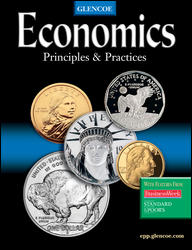
Economics Principles & PracticesChapter 14: Economic InstabilityChapter OverviewsChapter 14 deals with several problems that have plagued the United States economy: business cycles, unemployment, inflation, and poverty. Section 1 discusses business fluctuations and cycles. The Great Depression of the 1930s was the worst economic decline in United States history. The economy has been much more stable since World War II with a series of short, mild recessions. While seemingly unavoidable, business cycles can be anticipated with tools such as econometric models and statistical series such as the index of leading indicators. Section 2 deals with unemployment. Every month, the Census Bureau identifies unemployed persons. The number of unemployed is then divided by the civilian labor force to find the unemployment rate. The unemployment rate is comprehensive, but does not count the dropouts, nor does it distinguish between full- and part-time employment. The kinds of unemployment include frictional, structural, cyclical, seasonal, and technological unemployment. Section 3 explains how the price level is measured with various price indices. The change in the price level is the inflation rate, which is usually expressed in terms of percentage changes. Creeping inflation, galloping inflation, and hyperinflation are terms used to describe the severity of inflation. Generous credit conditions and excessive growth of the money supply are underlying causes of inflation. When these conditions are present, various kinds of inflation—including demand-pull, deficit spending, cost-push, and wage-price spiral—can take place. Section 4 examines the distribution of income that has become less equal over time. A number of factors account for the unequal distribution of income, including education, wealth, discrimination, ability, and monopoly power. Poverty, a relative measure determined by comparing the amount of money income earned by families to the poverty guidelines, is also examined. Over the years, various antipoverty programs—including the Earned Income Tax Credit (EITC), negative income tax, enterprise zones, and workfare—have been introduced to help those in the lowest income levels. |  |















